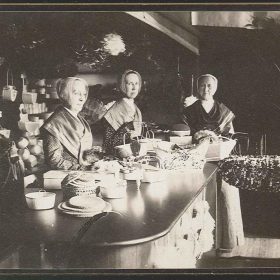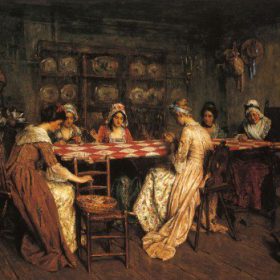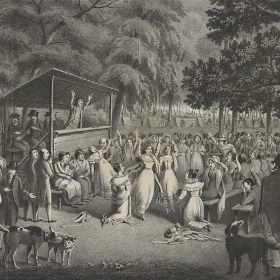図1. 1888年のケンタッキー産ウィスキーの広告
該当部分の概要
第2章のレベッカとリチャードの結婚式での宴会の場にてブラック・ベティーのボトル(the bottle of Black Betty) を競い合う描写がある。
“It was the custom then for the young men to ride swiftly on ahead, racing for the prize of the bottle of Black Betty.”
Janice Holt Giles, The Believers, Houghton Mifflin Company, 1957, p.11
景品であるブラック・ベティーのボトルを競い合って、若い男たちはわれ先にと馬に乗っていくのが習慣だった。
調査背景・目的・手法
- ブラック・ベティーのボトルが何を指すのかを明確にする調査である。ケンタッキー州もしくは周辺での当時の結婚式が描写されている資料を翻訳する。
- また、1の調査によりウィスキーである事がわかったため、本文中に出てくる様な結婚式での描写以外である、普段のウィスキーの需要やその背景を調べる事により、飲酒文化を通して18-19世紀のアメリカの生活への理解を深める。
- 現代での単語の使われ方に着目し、黒人差別用語として使用が懸念されている可能性を明確にするため事例を探す。
調査内容
- 1 ①ブラック・ベティーのボトルは本文上で結婚式での景品であったように、1800年代のアメリカにおいて結婚式での景品になることは伝統であったようだ。
以下の1876年に出版されたCaldwells’s Illustrated Combination Centennial Atlas of Washington Co. Pennsylvania of 1876にて、ケンタッキー州ではないがペンシルベニア州はワシントン郡での結婚式の様子が話されている事が確認できた。これよりブラック・ベティーが結婚式での景品であるウィスキーの事を指す事がわかる。以下p.12より引用。
“Processions were formed by the bridegroom and his friends going to the wedding, which was usually in double file, and about one mile from the house of their destination; two young men were singled out to run for a bottle of whisky; the more obstructed the road, the more honor the champion received for his success. He who succeeded in reaching the goal and securing the bottle of whisky proclaimed his triumph by a shrill war-whoop. On returning with the prize, which was called Black Betty, he gave the bottle first to the groom and his attendants, and to each in regular succession, reserving the bottle for himself by placing it in his hunting shirt. ”
J. A. Caldwell, Caldwells’s Illustrated Combination Centennial Atlas of Washington Co., Pennsylvania, 1876, p12.
花婿とその友人たちは二列の行列をなし結婚式に向かった。目的地より約1マイル(1.6km)離れた場所から、新浪側のグループの男性2人がウィスキーボトルを巡って競争した。道が困難であればあるほど、勝者は名誉を得ることができた。ゴールにたどり着きウィスキーボトルを手に入れた者は、その勝利を叫んだ。そしてそのブラック・ベティーと称される景品を持ち、新郎とそのグループへと戻ってくる。ウィスキーを最初に口にするのは新郎で、その後に新郎の友人たちが口にし、そして勝者は狩猟用のシャツの中にボトルをいれ、自分用に取っておいた。(筆者訳)
1.2 ②また、1882年に出版されたCollin’s Historical Sketches of Kentucky: History of Kentucky, Volume 2 においても、同様に結婚式でのウィスキーボトルをめぐる新郎の友人による競争が記載されている。そしてブラック・ベティーのボトルは結婚式の夜に新郎新婦の部屋に持っていかれたという記載がある。
“Pretty late in the night, some one would remind the company that the new couple must stand in need of some refreshments; ‘black betty,’which was the name of the bottle, was called for and sent up stairs, …”
Lewis Collins, Collin’s Historical Sketches of Kentucky: History of Kentucky, Volume 2, 1882, p163.
夜遅くになると、新婚カップルが飲み物が必要だろうと、ブラック・ベティーのボトルを階段を上り運んだ(以下略)(筆者訳)
小結:
ブラックベティー (Black Betty)のボトルはウィスキーのボトルである事が明確になった。結婚式にて景品になり皆に親しまれていた様子がわかった。
2.1 ③また、結婚式以外での使われ方として言葉自体に着目した。1736年のベンジャミンフランクリンにより出版されたThe Drinker’s Dictionaryには全228の表現が記載させており、この本ではブラックベティー(Black Betty)は酔いの表現として明記されている。この表現を見る上では、当時の人種差別の背景を感じ取れるとも受け取れる。
“He’s kiss’d black Betty.”
Benjamin Franklin, The Drinker’s Dictionary, The Pennsylvania Gazette, 1736, p173-178.
2.2 ④当時のアメリカでのウィスキーの需要を調べるために、値段を調べた。ウィスキーの値段はとても安く、その背景についてもオックスフォードジャーナルに1991年に掲載されたAlcohol in America にて確認できた。この記事は1700年代後期より1900年代後期までの、アメリカでの人々とアルコールの生活について述べている。
“After the revolution whiskey replaced run, since the British refused to supply it and the new federal government began to tax it in the 1790s. Whiskey also thrived because it was cheap. The settlement of the corn belt in Kentucky and Ohio created a corn glut. Western farmers could make no profit shipping corn overland to eastern markets, so they distilled corn into ‘liquid assets.’ By the 1820s, whiskey sold for twenty-five cents a gallon, making it cheaper than beer, wine, coffee, tea, or milk. In many places whiskey was also less dangerous than water, which was frequently contaminated.”
W.J.Rorabaugh, Alcohol in America, Oxford University Press, 1991, p.17
アメリカ独立戦争後、ウィスキーはラムより流行った。というのも、イギリスはラムの供給を拒否し、新しい連邦政府は1790年代に課税し始め、そしてウィスキーは安かったからだ。ケンタッキー州やオハイオ州での、とうもろこし栽培の入植は過剰にとうもろこしを生産した。西部の農民たちは、とうもろこしを陸路で東部市場へ送っても利益をあげられなかった。そのため、とうもろこしを「液体の資産」として蒸留した。1820年代までには、ウィスキーは1ガロン25セントで売られており、ビールやワイン、コーヒー、お茶、ミルクよりも安かった。また、多くの場所で水はよく汚染されていたため、ウィスキーは比較的安全であった。(筆者訳)
2.3 ⑤さらに同じ記事より、当時の人々がどのくらいアルコール摂取していたのか、そしていかに宗教が飲酒文化へ介入していったかが説明されている。
“By 1830 consumption of alcohol, mostly in the form of whiskey, had reached more than seven gallons a year for every person over age fifteen or three times the current rate….
Instead of a morning coffee break, Americans stopped work at 11:00a.m. to drink….However, there was growing opposition to alcohol.
The earliest attacks on alcohol came during the late 1700s from Methodists and Quakers….
Protestant ministers shifted the attack against alcohol from the issue of health to the question of sin.…Soon churches required members to take a pledge not to drink.
By1850, the consumption of alcohol had dropped by more than half.”
W.J.Rorabaugh, Alcohol in America, Oxford University Press, 1991, p.17
1830年には、15歳以上の個人の年間摂取量(主にウィスキー)は現在に比べて3倍以上の7ガロン(26リットル)に達していた。(中略) 朝のコーヒー休憩のかわりに、アメリカ人は11時に仕事を止めて酒を飲んだ。(中略) しかし、アルコールに対する反感が高まっていた。1700年代後半には初期のアルコールに対する反対運動がメソジストとクエーカー教より行われた。(中略) プロテスタント派の牧師たちは、このアルコールに対する反対運動を、健康問題ではなく罪への問題へと変えた。(中略) まもなくして教会では教徒たちにアルコールを飲まないと誓わせた。そして1850年までには、アルコール摂取量は半分以下まで下がった。(筆者訳)
3.1 ⑥ また、1992年に出版されたCharles Wolf and Kip LornellのThe Life and Legend of Leadbellyではブラック・ベティーは銃のニックネームとして使われていたり、2006年のAssociated Press著 “Fight Song for UNH Hockey Team Banned as Potentially Racist” ではRam Jamのブラック・ベティーという黒人女性との恋愛を歌った曲をニューハンプシャー大学のホッケーゲームでのテーマソングとして使用していたが、人種差別の視点から廃止したことなどが確認できた。
まとめ
ブラック・ベティーは現代社会では銃のニックネームや人種差別用語として扱われる言葉であるが、19世紀前後では結婚式の習わしの中で景品となるウイスキーボトルとして親しまれていた。これらのウィスキーは、アメリカのイギリスからの独立や、西部地域でのとうもろこし産業の活性化が背景となり、比較的安く入手できるものであった。そして水よりも安心して飲めたウィスキーは多量に飲まれ、当時の人々とウィスキーとの強いつながりが見られる。しかしその後、キリスト教はお酒を飲むことは罪とし、人々へ精神面からのアプローチをかけ、結果的に飲酒量が下がった。当時の教会の威力、そして体調の心配よりも人々の罪への意識の方が強かったことなどが見られる。
(執筆: 佐久間 美夢)
図版出典・参考文献
参考文献
・J. A. Caldwell, Caldwells’s Illustrated Combination Centennial Atlas of Washington Co., Pennsylvania, 1876
http://digitalcollections.powerlibrary.org/cdm/compoundobject/collection/sstlp-colex/id/33270/rec/18 (最終閲覧 2020.02.24)
・Lewis Collins, Collin’s Historical Sketches of Kentucky: History of Kentucky, Volume 2, 1882
https://books.google.co.jp/books/about/Collins_Historical_Sketches_of_Kentucky.html?id=gZFQAQAAIAAJ&printsec=frontcover&source=kp_read_button&redir_esc=y#v=onepage&q=black%20betty&f=false (最終閲覧 2020.02.24)
・Benjamin Franklin, The Drinker’s Dictionary, The Pennsylvania Gazette, 1736
https://founders.archives.gov/documents/Franklin/01-02-02-0029 (最終閲覧 2020.02.24)
・W.J.Rorabaugh, Alcohol in America, Oxford University Press, 1991
https://www.jstor.org/stable/25162814?seq=1 (最終閲覧 2020.02.24)
・Charles Wolf and Kip Lornell, The Life and Legend of Leadbelly, HarperCollins, 1992
https://archive.org/details/lifelegendoflead00wolfe/page/298/mode/2up?q=black+betty (最終閲覧 2020.03.20)
・Associated Press, “Fight Song for UNH Hockey Team Banned as Potentially Racist,” Diverse Education, 2006 (最終閲覧 2020.03.20)
https://diverseeducation.com/article/5492/
Fight Song for UNH Hockey Team Banned as Potentially Racist
図版出典
図1: California Secretary of State’s Office, “Old Series Trademark No. 1636,” California State Archives Exhibits, accessed February 23, 2021, http://exhibits.sos.ca.gov/items/show/1555.
図2: Manuscripts and Archives Division, The New York Public Library. “Signed receipts for whiskey” The New York Public Library Digital Collections. 1793 – 1795. https://digitalcollections.nypl.org/items/daf346d0-042a-0134-f8f5-00505686a51c






